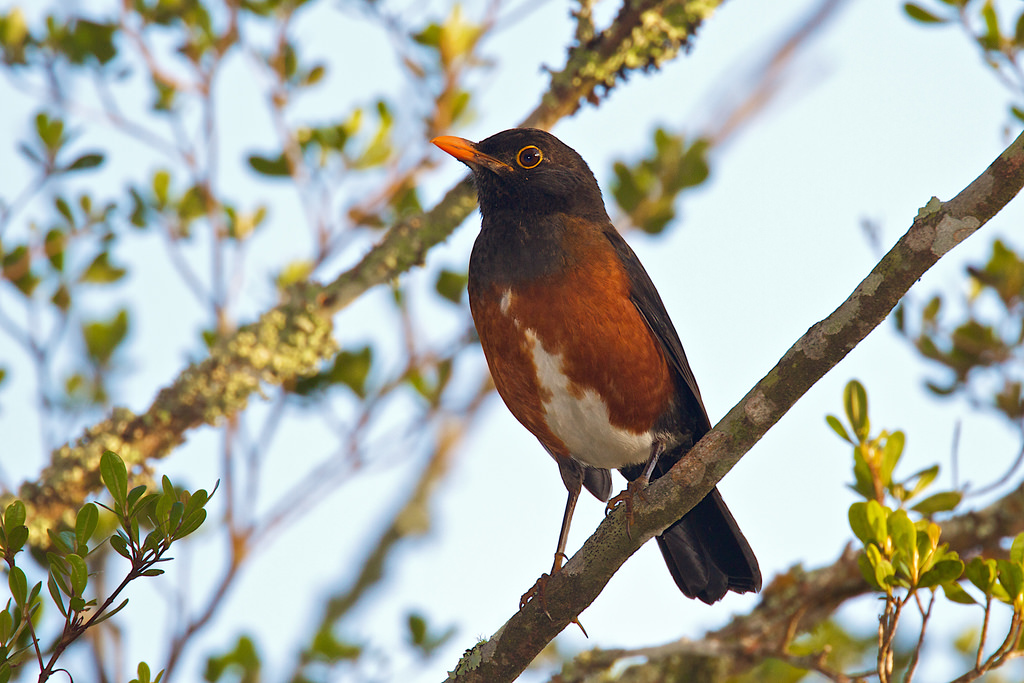Abyssinian ground-thrush
(Turdus swalesi)

Description
Turdus swalesi, commonly known as the Abyssinian ground-thrush, is a medium-sized bird that belongs to the thrush family. This species is found in the highland forests of Ethiopia, Eritrea, and Somalia, where it inhabits dense undergrowth and forest edges. The Abyssinian ground-thrush is a fascinating bird species, and in this article, we will explore various aspects of its biology, ecology, behavior, and conservation. Physical Characteristics The Abyssinian ground-thrush is a medium-sized bird, measuring about 21-23 cm in length and weighing approximately 63-90 g. Males and females are similar in appearance, with both having an overall brownish-grey plumage with fine white spots on their underparts. They have a distinctive yellow-orange eye-ring, which is encircled by a blackish patch. The Abyssinian ground-thrush also has a short and stubby bill, which is yellowish in color. Habitat and Distribution The Abyssinian ground-thrush is endemic to the highland forests of Ethiopia, Eritrea, and Somalia. It is found at altitudes of between 1,800-3,600 meters above sea level, where it inhabits dense undergrowth and forest edges. This species prefers moist and shaded habitats with a high diversity of plant species, including bamboo thickets, montane forests, and evergreen forests. The Abyssinian ground-thrush is a resident bird species, which means it does not migrate. Diet and Feeding Behavior The Abyssinian ground-thrush feeds mainly on insects, earthworms, and other invertebrates, which it forages on the forest floor. It uses its short and stout bill to probe the leaf litter and soil for prey, and it occasionally hops up onto low branches to catch flying insects. This species has also been observed to feed on fruits and seeds, especially during the dry season when insects are scarce. Breeding and Reproduction The breeding behavior of the Abyssinian ground-thrush is not well known. However, it is believed to breed during the rainy season, which lasts from June to September. During this period, males are known to sing from high perches in the forest canopy to attract females. The nest of the Abyssinian ground-thrush is a cup-shaped structure made of twigs, moss, and other plant materials. It is usually built on a horizontal branch or fork of a tree, about 1-3 meters above the ground. The female lays 2-3 eggs, which are incubated by both parents for about 12-14 days. The chicks are altricial, which means they are born naked and helpless, and are fed by their parents for several weeks until they fledge. Behavior and Ecology The Abyssinian ground-thrush is a shy and elusive bird species that is often difficult to observe in the wild. It spends most of its time foraging on the forest floor, where it blends in with the leaf litter and soil, making it hard to spot. This species is known to be territorial, with males defending their breeding territories against intruders. The Abyssinian ground-thrush is also a solitary bird, although pairs or small family groups may be observed during the breeding season. Conservation Status The conservation status of Turdus swalesi, also known as the Abyssinian ground-thrush, is Near Threatened, according to the International Union for Conservation of Nature (IUCN). This means that the species is at risk of becoming endangered in the near future if conservation actions are not taken. The main threat to this species is habitat loss due to deforestation and conversion of forested areas to agricultural land. The highland forests of Ethiopia, Eritrea, and Somalia, where the Abyssinian ground-thrush is found, are under intense pressure from human activities such as logging, charcoal production, and settlement. Climate change is also likely to have an impact on the species, as it could alter the forest habitat and disrupt the breeding cycle of the bird. Conservation efforts to protect the remaining forests in the species' range and promote sustainable land use practices are essential to ensure the long-term survival of the Abyssinian ground-thrush.
Taxonomic tree:







